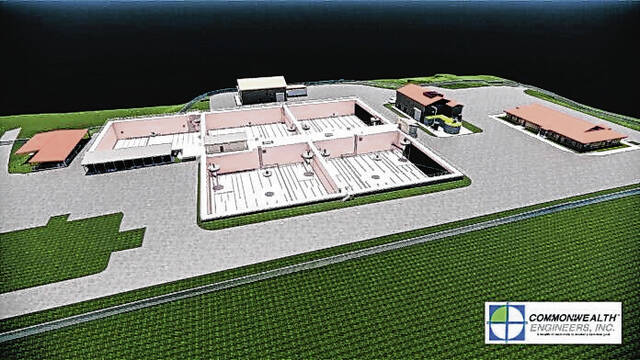
The new wastewater treatment plant will be built near the existing facility at the city complex at 809 S. State St.
GREENFIELD — Environmental problems with the site of Greenfield’s new wastewater treatment plant could lead to an even greater increase in fees for utility customers.
Wastewater rates are already set to nearly double for city residents by the beginning of 2022. The new revenue was intended to pay for the cost of constructing the plant, originally estimated at $39 million. The new plant is needed not only to increase the city’s capacity, but also to comply with environmental requirements on removing phosphorus from wastewater.
Wastewater utility manager Nick Dezelan said the site of the planned new treatment plant — near the existing plant at 809 S. State St. — is difficult to build on because it is the location of Greenfield’s old city dump. However, piping in the city runs in such a way that the only viable place to build a new treatment plant is adjacent to the old one.
Soil and other materials need to be removed from the site because the presence of the dump resulted in contamination. Dezelan said it has been more time-consuming and expensive to remove materials than the city originally expected when making plans for the new plant. However, that process has been proceeding well so far.
“Knock on wood, we haven’t run into any major surprises or anything yet,” he said.
City financial adviser Buzz Krohn said it is premature to make any statements about the final cost of the plant’s construction, since bids for construction have not been made yet. He estimated the cost of the environmental remediation needed at the site at about $5 million.
Krohn said the city knew there would likely need to be removal of soil at the site, but “nobody knew to what extent” until samples were tested. Now, that soil needs to be excavated and carried by truck to a landfill, which has driven up costs.
The increase in costs might not stop there, since the COVID-19 pandemic has driven up the prices of both construction material and labor.
Krohn was reluctant to make a statement on whether the final cost of the project would require another utility rate increase for Greenfield customers, but said there was a chance the cost might not be covered by the three-step increase. He added that the city would likely re-apply for the State Water Infrastructure Grant program intended for such projects, which he said turned down Greenfield’s initial request in part because of its relatively low utility rate at the time.
“We’re looking at other grant opportunities also,” he said.
The first two phases of the three-step wastewater rate increase took place in July 2020 and March 2021, with the third set for January 2022. The total increase in cost between the three, for an average residential customer, will be from about $19.77 in 2020 to $36.89 in 2022, or 87%.
Another increase would come on top of that amount as well as a smaller recent increase to water and electric rates.
Krohn said even if there is another rate increase, the benefits of building a new wastewater treatment plant are going to eventually outweigh the costs for Greenfield residents. Building a new plant with a higher capacity will allow the city to avoid a ban on new sewer hookups and continue growing.
“Wastewater is one of the most important public health and safety responsibilities that the city has,” Krohn said.
Dezelan said the wastewater utility has been working closely with the Indiana Department of Environmental Management on making sure the new site meets state environmental standards.
“So far, it’s been really good working with them,” he said.
Dezelan said the project’s engineer is working to keep costs down as much as possible. A better estimate of what the project will cost should be available in January or February, he said, when it is expected to go out for construction bids.
